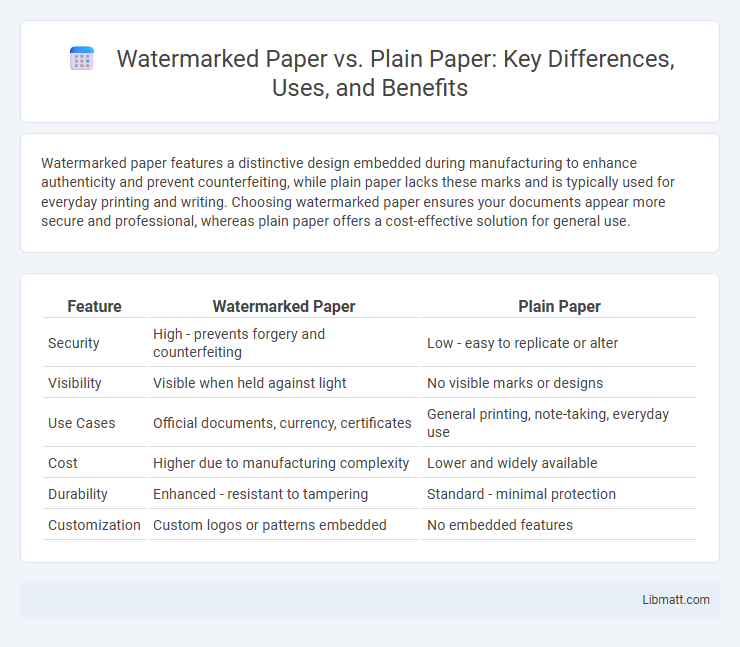Watermarked paper features a distinctive design embedded during manufacturing to enhance authenticity and prevent counterfeiting, while plain paper lacks these marks and is typically used for everyday printing and writing. Choosing watermarked paper ensures your documents appear more secure and professional, whereas plain paper offers a cost-effective solution for general use.
Table of Comparison
| Feature | Watermarked Paper | Plain Paper |
|---|---|---|
| Security | High - prevents forgery and counterfeiting | Low - easy to replicate or alter |
| Visibility | Visible when held against light | No visible marks or designs |
| Use Cases | Official documents, currency, certificates | General printing, note-taking, everyday use |
| Cost | Higher due to manufacturing complexity | Lower and widely available |
| Durability | Enhanced - resistant to tampering | Standard - minimal protection |
| Customization | Custom logos or patterns embedded | No embedded features |
Introduction to Watermarked and Plain Paper
Watermarked paper features a distinctive design embedded into the fibers during manufacturing, providing authenticity and security for important documents. Plain paper, lacking such embedded patterns, is commonly used for everyday printing and general writing purposes. Your choice between watermarked and plain paper depends on the need for verification, durability, and presentation quality.
Historical Background of Watermarked Paper
Watermarked paper dates back to the 13th century in Italy, where it was initially used by paper manufacturers to identify their products and prevent forgery. Unlike plain paper, watermarked paper contains unique designs or patterns embedded during the papermaking process, enhancing authenticity and security. Your choice of watermarked paper reflects a rich historical tradition valued for its blend of artistry and protection.
How Watermarked Paper is Made
Watermarked paper is created by impressing a specific design or pattern into the paper fibers during the manufacturing process, usually with a dandy roll or cylinder mold fitted with a raised pattern. This technique alters the paper's thickness, creating a translucent watermark that is visible when held against light, enhancing security and authenticity. Your documents become more secure and professional with the unique texture and identification that watermarked paper provides.
Characteristics of Plain Paper
Plain paper features a smooth, uniform surface without any embedded patterns or markings, making it ideal for everyday printing and writing tasks. It is typically more affordable and widely available compared to watermarked paper, providing versatility for various applications. The absence of visible security features means it lacks authentication elements found in watermarked paper, making it less suitable for official documents or secure printing needs.
Security Features: Watermarked vs. Plain Paper
Watermarked paper incorporates embedded security features such as translucent designs or logos that are visible when held up to light, making it difficult to counterfeit or alter. In contrast, plain paper lacks these intrinsic markers, rendering it vulnerable to forgery and unauthorized reproduction. Your choice of paper significantly impacts document authenticity and protection against fraud.
Applications and Use Cases
Watermarked paper is widely used in official documents, certificates, and currency to enhance security and prevent counterfeiting, making it ideal for legal papers, diplomas, and government-issued IDs. Plain paper is commonly utilized for everyday printing, note-taking, and office correspondence, offering versatile and cost-effective solutions for general use. The choice between watermarked and plain paper depends on the need for authenticity verification versus standard document production.
Cost Comparison and Availability
Watermarked paper typically costs more than plain paper due to the specialized manufacturing process and added security features, making it less readily available in standard office supply stores. Plain paper remains widely accessible and budget-friendly, suitable for everyday printing needs without additional expense. You should consider watermarking only when document authenticity and security are priorities, as it impacts both cost and procurement options.
Environmental Impact
Watermarked paper typically has a higher environmental impact due to the additional manufacturing processes required to create the watermark, which often involves extra water and energy consumption. Plain paper generally produces less waste and uses fewer resources during production, making it a more eco-friendly choice for everyday use. Choosing recycled plain paper significantly reduces the carbon footprint compared to both plain and watermarked virgin papers.
Pros and Cons of Watermarked Paper
Watermarked paper offers enhanced security and authenticity verification, making it ideal for official documents, certificates, and legal papers, as it is difficult to replicate. Its main drawback is the higher cost compared to plain paper, which may not be suitable for everyday printing needs or bulk usage. Additionally, watermarked paper can limit printing options and may cause issues with certain printers or copiers due to its textured design.
Choosing the Right Paper for Your Needs
Watermarked paper offers enhanced authenticity and a professional appearance, making it ideal for official documents and certificates, while plain paper provides versatility and cost-efficiency for everyday printing tasks. Your choice depends on the importance of security and presentation versus budget and practicality. Selecting the right paper ensures your documents meet both functional and aesthetic requirements effectively.
Watermarked paper vs plain paper Infographic

 libmatt.com
libmatt.com